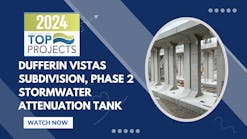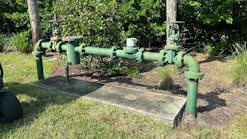If you haven’t looked at asphalt pavers in a while, you might want to consider a brand other than the one you’re used to. The manufacturers have improved their machines, so the choices are broader than ever. Grading & Excavation Contractor asked five major asphalt paver manufacturers about how to select a paver for highway and street applications, and the answers are insightful.
“Asphalt paving contractors will want to have the most versatile pavers they can get,” says Mark Stang, vice president with Vögele. “That will include 8-foot or 10-foot wheel or tracked pavers, which are suitable for jobs from parking lots to residential streets to mainline paving.”
From Vögele, a division of the Wirtgen Group, such pavers will include the new 10-foot tracked Vision 5200-2i and 10-foot wheeled Vision 5203-2i, and the 8-foot tracked Vision 5100-2 and the 8-foot wheeled Vision 5103-2.
The new tracked Vision 5200-2i has a maximum paving width of 28 feet and a transport width of 10 feet, while the new wheeled Vision 5203-2i has a maximum paving width of 26 feet and a transport width of 10 feet. Both models meet Tier 4-interim emission standards.
The Vision 5203-2i paver provides the benefits of next-generation Vision pavers in a wheeled design. The 5203-2i also can pave at speeds up to 250 fpm, but travel up to 12 mph, both infinitely variable.
The Vision 5200-2i and 5203-2i-like the 8-foot Vision 5100-2 and 5103-2 pavers-are equipped with ErgoPlus, Vögele’s total design concept for easy paver operation. ErgoPlus simplifies the operators’ work and provides comfort, while offering owners unobstructed operator visibility of material hopper, screed, and auger tunnel.
“Screeds contribute to versatility as well,” Stang says. “With front-mount screeds, extensions are mounted forward of the main screed, permitting faster screed retraction, reducing trapped material, compared to rear-mount screeds. Front-mounted screeds give you exceptional versatility on applications with varying width requirements, such as parking lots with islands and light poles, residential and city streets with storm sewers, gas and water mains, and county roads with multiple obstructions.”
The new front-mount VF 500 screed from Vögele is designed for use with the 8-foot Vision pavers, and is the shorter version of the successful 10-foot VF 600 screed for the 10-foot Vision pavers. The VF 500 is equipped with vibration across the full paving width, up to 15 feet, 6 inches. Its basic width is 8 feet, and it can be extended hydraulically up to 15 feet, 6 inches. With bolt-on extensions fitted, it builds up to a maximum width of 21 feet, 6 inches. The similar VF 600 has a basic width of 10 feet, infinitely variable from 10 feet to 19 feet, 6 inches, to a maximum width of 25 feet, 6 inches.
Grade-and-slope automation is controlled by Vögele’s exclusive Niveltronic Plus. With Niveltronic Plus, automated grade-and-slope control is integrated into the dual-screed control stations, allowing the operator to switch back and forth between normal screed functions and automated grade-and-slope controls.
The system permits automatic recognition of sensors connected for easy and quick setup. Calibrations of operating parameters are not required, as Navitronic Plus is designed to match Vögele’s hydraulic and control circuits.
Because the Niveltronic Plus system is integral with the paver’s control system, it is always easily accessible to the paving crew. With Niveltonic Plus, operators can also monitor slope directly from the screed control displays, eliminating the need for the use of smart levels.
Roadtec’s Interstate Pavers
The Roadtec asphalt pavers best fitted for interstate highway work are the RP-190e and RP-195e. Both machines are powered by Tier 4i 230-horsepower Cummins QSB 6.7 engines. Both the RP-190e and RP-195e are cooled by variable speed, hydraulically driven fans that provide cooling based on engine demand to enhance fuel efficiency and decrease noise levels.
All Roadtec pavers include such features as flow gates and delta plates to decrease material segregation and provide the operator with enhanced control over head of material. More durable wear parts are included on the Roadtec pavers to reduce operating costs and time spent replacing wear components.
The RP-190e and RP-195e each have a base paving width of 10 feet. For an interstate job where paving width remains consistent, an Eagle 10 screed with rear-mounted hydraulic extensions is preferable. The Eagle 10 is electrically heated. The height of the screed is easily adjustable from the screed operator position. The screed control boxes on these two machines are also equipped with a screen displaying auger position and other important variables of the paver and screed.
The RPO-190e is a rubber-tire machine, and the RP-195e is a tracked machine. Topography and base material must be taken into consideration when deciding which type of paver is ideal. Rubber-tire pavers are lighter and more maneuverable. If the project is being performed on a strong base material and gentle grade, a rubber-tire paver is preferred. Tracked pavers offer better weight distribution and stability, making them the preferred paver for a project with steeper grade or weaker base material.
The hopper capacity of the RP-195e is 13.8 tons. Considering this is an interstate project with smoothness incentives, material segregation, thermal segregation, and trucking issues should all be considered and accounted for. With this in mind, a Shuttle Buggy SB-2500e would be ideal as a means of storing and remixing the asphalt. The SB-2500e helps control material and thermal segregation in the asphalt mix. It also allows the paver to operate continuously, which eliminates unnecessary stops and potential bumps in the mat.
Screed automation is an extremely beneficial tool in road construction. The RP-190e and RP-195e can be equipped with either Topcon or MOBA grade and slope controls. If used correctly, both systems can make the paving operation smoother and more consistent.
The RP-190e and RP-195e come standard with the Guardian Remote Telematics system. With this new technology from Roadtec, the owner of the machine can monitor various machine aspects such as hydraulics, electronics, fuel consumption, auger speed, and flowgate height in real-time via cellular signal.
A Wide Range From Caterpillar
Caterpillar offers a full range of 8-foot and 10-foot pavers with front-mounted screed extensions or rear-mounted extensions or a tamper bar screed.
Caterpillar’s AS4252C screed, which features a tamper bar design used primarily in Europe, has heated end gates available as an option. Other Cat screeds utilize a vibratory design common to North American paving and do not offer heated end gates at this time. All Cat screeds have electric heat. Electric heat is reliable, consistent, and offers a more comfortable work environment than diesel or LP screeds.
Power controls for main screed crown, extender height, and slope simplify adjustment with a switch in the screed control panel. Thickness control screws are available with left- or right-hand threads and equipped with spinner handles for fast, easy adjustment.
Caterpillar offers wheeled pavers and tracked pavers. Tracked pavers offer better traction, which is key when making wide pulls or pulling up a grade. Tracked pavers provide better floatation on loose base materials as well. Often, tracked pavers are slower to move around a job site.
Cat pavers are available with the exclusive Mobil-Trac undercarriage, which offers the advantages of a tracked paver with the mobility and speed of a wheeled paver. The Mobil-Trac undercarriage utilizes rubber belt tracks and an oscillating bogey design that minimizes tow point movement, which contributes to smooth results. The AP655D is still available with a steel track undercarriage as well as the Mobil-Trac undercarriage, but most customers prefer the Mobil-Trac undercarriage.
Cat pavers are available with optional Cat Grade and Slope, a control system integrated with the paver and screed. The system is designed for optimal performance on Cat pavers and will provide the best results.
Cat pavers can be equipped with either Trimble or Topcon systems, and either system can be calibrated to produce excellent smoothness. Any system should be calibrated to the machine it is intended to be used on. For optimum results, it is important to consult with the Cat dealer when setting up the Topcon or Trimble systems, as the out-of-the-box settings for these systems are often general defaults and may not make the best use of the capabilities of the paver.
One of the best ways to earn smoothness bonuses is through crew training. Caterpillar offers extensive paver operation training programs, as well as onsite consulting.
Bomag now Sells Pavers
At World of Asphalt, we talked with Bill Rieken, a road-building specialist with Bomag, of the Fayat Group. Bomag now markets a line of asphalt pavers, which Fayat Group bought from Terex. That same line of pavers formerly belonged for many years to Cedarapids, which was sold to Terex.
For highway paving, either Bomag/Cedarapids’ CR 462, a rubber-tracked 10-foot paver, or the CR 452, a rubber-tired version, can do the job handily. Contractors tend to like either tracked or rubber-tired pavers, but a few have both types, Rieken says.
“Our rubber-tired pavers offer better tractive effort, because we have large drive tires and patented three-point suspension,” says Rieken. The three-point suspension allows the back of the paver to raise and lower hydraulically and automatically maintain equal ground pressure on both sides of the paver. “And because you have the same pressure, it enhances tractive effort,” Rieken says.
Another patented feature of Bomag pavers is a screed assist system to minimize settling when the paver stops. “We can adjust the screed assist pressure, which reduces ground pressure, because we put lift pressure on the screed lift cylinders,” says Rieken.
Rieken says that rear-mounted screed extensions will definitely provide a mat with more uniform density and mat texture. “When you go to a front-extendable screed, you’re sacrificing quality of the asphalt mat for what people perceive as screed user friendliness,” says Rieken. “Front-mounted extensions are just for commercial paving-they are a driveway and parking lot screed.
“Every manufacturer offers a rear-extendable screed, and that would be the screed of choice for highway work, county roads, and city streets,” Rieken says. Front-mounted extensions do not permit the paver to achieve uniform density across the mat, he says.
Throughput Capacity
We also talked to John Mooney, who is product manager for paving and milling products, Volvo Construction Equipment, North America. Like the other four manufacturers discussed here, Volvo offers a range of asphalt pavers. Mooney addressed the rate of flow of asphalt through a paver. “As you feed the paver, the volume that you’re delivering has to give you enough time, as you’re moving forward paving. And you would calculate the width that you’re paving by the thickness that you’re paving by the speed that you’re paving, and that will determine what your cycle times on your trucks would be,” Mooney says.
“So if we’re looking at a 22-ton delivery, and you’re paving 2-inches thick, you’re going to have a much faster speed of paving than if you were paving 4-inches thick,” Mooney says. “Based on how I teach in my best practices of paving, would be that I look at cycle times. From the time that a truck would be unloaded to the next truck that would be unloaded would be a cycle. And generally we look at cycles of right around five to six or seven minutes, and that would determine the amount of tonnage that I’m putting through the machine. It would also determine how many trucks I would have going from the asphalt plant to the paver. So you look at the rate of speed of the paver.”
For highway paving, Mooney recommends either a Volvo model 7110, a tracked machine, or a Model 7170, the wheeled machine. “Generally speaking, I find that tracked machines give you a far more stable platform to run your automation off of, so they would show up more on the heavy highway side. But if you are paving a rural road, a back road, or streets in a municipality, you may choose a wheeled machine. Traditionally, wheeled machines are much faster in speed for moving it from one place to the other.
“Generally speaking, a rubber-tired machine has lower overall life cycle costs because replacing tracks can be rather expensive,” Mooney says. “But what happens with a rubber tire is that whenever you’re paving, generally within automation, your tires will flex much like in your car. The sidewall of the tire is moving left and right. And that’s what occurs on a paver. As the paver is feeding material across the material flow channels, the surge of material against the end plate forces the machine to move back and forth, left and right.
“But on a tracked machine, that won’t happen,” Mooney says. “It’s more stable. Does that interfere with the quality of paving? What I’m going to say is that on a heavy-highway application, an Interstate, that the requirements for those jobs are so specific on their profilograph readings that they must comply with, that tracks will give you a better solid platform for your automation, regardless of whose automation it is.”






